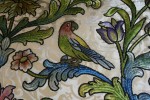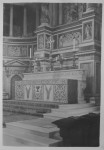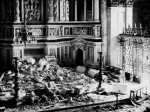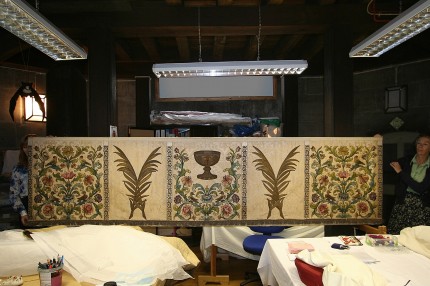
An altar frontal that was hand embroidered by 133 soldiers as they recovered from their injuries during World War I will be going back on display at St. Paul’s Cathedral in London for the first time in 70 years. Commonwealth soldiers from the UK, Australia, Canada, New Zealand and South Africa convalescing at hospitals all over Britain contributed to the altarpiece, embroidering sections of five panels which were then stitched together by experts at the Royal School of Needlework. The final product is almost 10 feet wide and features intricate floral patterns alternating with two palm branches, signifying martyrdom’s spiritual victory over the flesh. The central panel is the chalice of the Eucharist, representing Christ’s suffering for the forgiveness of sin, above a floral field.
 The altar cloth was organized by the Royal School of Needlework as a form of occupational therapy for recovering soldiers. Occupational therapy, the idea that working could be physically and psychologically beneficial for trauma patients, began during World War I as treatment for shellshocked and injured soldiers. Patients learned arts and crafts like basket weaving and painting and, if they were physically able, heavier skills like woodwork and welding. For the war wounded, “lap crafts,” work that could be done while seated, were particularly useful, and embroidery, cross-stitching and other needlework coupled the convenience of a lap craft with the development of fine motor skills and coordination invaluable to men with limb injuries and the painful ticks and tremors of shell shock. Sewing was both physical therapy and a welcome distraction from their suffering. It didn’t require the use of heavy machinery or tools, nor even a workbench. Wounded men could stitch while sitting comfortably in bed.
The altar cloth was organized by the Royal School of Needlework as a form of occupational therapy for recovering soldiers. Occupational therapy, the idea that working could be physically and psychologically beneficial for trauma patients, began during World War I as treatment for shellshocked and injured soldiers. Patients learned arts and crafts like basket weaving and painting and, if they were physically able, heavier skills like woodwork and welding. For the war wounded, “lap crafts,” work that could be done while seated, were particularly useful, and embroidery, cross-stitching and other needlework coupled the convenience of a lap craft with the development of fine motor skills and coordination invaluable to men with limb injuries and the painful ticks and tremors of shell shock. Sewing was both physical therapy and a welcome distraction from their suffering. It didn’t require the use of heavy machinery or tools, nor even a workbench. Wounded men could stitch while sitting comfortably in bed.
Needlework also had the marked advantage of a wide pool of potential teachers, thanks to the army of women on the homefront who volunteered for the Red Cross or local organizations like the Khaki Club in Bradford which deployed embroidery master Louisa Pesel to help a group of soldiers recovering at the Abram Peel Hospital in Leeds to cross-stitch an altar frontal of their own for use at the hospital chapel.
 The final stage of stitching together the panels of St. Paul’s altar cloth was completed after the war ended. The finished product was then presented to St. Paul’s Cathedral where for decades it graced the front of the cathedral’s high altar. It was removed for its own safety after St. Paul’s was hit by German bombs during the Blitz. One bomb dropped in October of 1940 was a direct hit, obliterating the altar. You can see the aftermath of another bombing in 1941 in this silent footage from British Pathé.
The final stage of stitching together the panels of St. Paul’s altar cloth was completed after the war ended. The finished product was then presented to St. Paul’s Cathedral where for decades it graced the front of the cathedral’s high altar. It was removed for its own safety after St. Paul’s was hit by German bombs during the Blitz. One bomb dropped in October of 1940 was a direct hit, obliterating the altar. You can see the aftermath of another bombing in 1941 in this silent footage from British Pathé.
 When the war was over and the high altar rebuilt, its dimensions were different so the World War I frontal no longer fit. It was kept in a chest for more than 70 years until the cathedral decided to conserve it for display on the centenary of the beginning of World War I. The frontal is now being restored by the cathedral’s borderers (embroiderers and members of the medieval guild which still exists today). When the repair work is done, the textile will be used for the first time since World War II at a special service on August 3rd, 2014, the hundredth anniversary of the day Germany declared war on France and began an invasion through neutral Belgium triggering Britain’s entry in the war. After that, it will be go on display in a dedicated space in the cathedral for four years until the centenary of armistice.
When the war was over and the high altar rebuilt, its dimensions were different so the World War I frontal no longer fit. It was kept in a chest for more than 70 years until the cathedral decided to conserve it for display on the centenary of the beginning of World War I. The frontal is now being restored by the cathedral’s borderers (embroiderers and members of the medieval guild which still exists today). When the repair work is done, the textile will be used for the first time since World War II at a special service on August 3rd, 2014, the hundredth anniversary of the day Germany declared war on France and began an invasion through neutral Belgium triggering Britain’s entry in the war. After that, it will be go on display in a dedicated space in the cathedral for four years until the centenary of armistice.
To pay tribute to the 133 soldiers who contributed to the altar frontal, St. Paul’s officials would like relatives of the men to contact them. They’re hoping photographs, letters, mementos, family stories can be included in the display to give visitors a more personal understanding of the soldiers’ lives. Researchers have compiled a complete list of their names, ranks, regiments and the hospitals they were staying at when they worked on the frontal. Here is the complete list in an Excel spreadsheet. If you have relatives who fought for Britain in World War I and were hospitalized there, do check the list. If you see a name you recognize, contact the Reverend Canon Michael Hampel at precentor@stpaulscathedral.org.uk.

Embroidery is my hobby. That is LOVELY! I am glad to hear that the Tailors of Gloucester (and everywhere else)were very busy. 🙂
At a time when the medical profession had no clue about shell shock being a true and horrible condition, the idea of keeping damaged soldiers educated and busy with creative tasks was a brilliant one. The long months in hospital would have been a nightmare, without meaningful tasks.
But I wonder if male soldiers felt that needlework crafts would emasculate them even further. Woodwork and welding, where possible, might have been more popular amongst the men.
@Hels: Apparently not. Sailors have always tended to pick up decorative arts to while away the boring hours.
From the mid-19th C, it was ‘woolies’, pictures made of wool yarn. This practice ended with the start of WWI, but transferring the art/skill seems to have gone smoothly.
http://www.antiquesandfineart.com/articles/article.cfm?request=311
http://www.vandekar.com/sailors-woolies-woolwork-pictures.asp
The condition that apparenly some of the shellshocked WWI participants were in, makes it a little hard to imagine how they could ever do embroidery. Moreover, that Altar cloth seems to be remarkably free from all kinds of pathos, false patriotism and propaganda. In contrast to e.g. much earlier pieces like the Bayeux Tapestry, which was also stored in churches, but presumably was not designed as a massive, 70 meter Altar cloth, nor to be exhibited behind glass.
The work looks incomplete. On the top panels there are lines for extending the borders. Perhaps the war ended before the work was completed? It is an exquisitely beautiful work and the quality of the stitching is uniform throughout though over 130 men worked on it. It looks like it was done by one hand.
Sorry, I see on the altar picture there is another fringed panel that lays over the top edge.
A better term than “injured” would be “wounded”, with its connotations of injury in combat. The injury could be physical or mental. The embroidery could have been done, of course, by soldiers who suffered physical wounds, too, of course.
(reference my comment above) – that said, the Khaki club was formed at a hospital devoted to treating soldiers with neurological disorders which certainly would have included “shell shock”. I would imagine we will learn a great deal more about how that generation came to understand psychological damage as the centenary progresses.
Simply lovely. As for the attitude of men doing needlework, I think it was less during those days than later. My father (American) was not in WWI, having been born in 1911. His mother was widowed young, and my father and his many brothers helped sustain the family by doing fine crocheting with her in addition to doing field work. For centuries, many men and boys employed what we now think of only as “women’s needlework” as part of a trade, and in their spare time, used those skills in creative ways to produce decorative items. My father was proud of his skills with a needle.
My father served in WWI. I have several of his drawings while serving in France, one of which I transferred to fabric and embroidered best I could. I have lists of members of Camp Dix Contingent, Headquarters Company_309th Field Artillery.jpg, and pictures of his unit. I am 74 and working again on my blog. When I get it updated I will do a post, with pictures.
Lucien (Lucy)
And soldiers would have known how to darn their socks, sew on buttons etc
The frontal piece is so beautiful. It’s inspiring to know that creating beautiful embroidery helped them to emotionally heal from all they went through in WWI.
My mother, my sister, niece, my husband and myself travelled to London from Australia to view this altar cloth. My mother was the niece of one of the soldiers who worked on this piece. John Till came from Hay NSW and unfortunately never made it home as he died in 1919, not long after the war ended. We were special guests of St Paul’s and it was a very emotional and overwhelming day. The cloth itself was very beautiful and it was an honour to be there. We went on to visit Johns grave at Oxford and also the church where he married a nurse.
Thank you for your post. I hope you’d like to add to https://livesofthefirstworldwar.org/lifestory/7632066 .